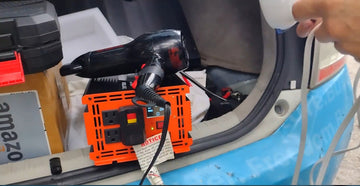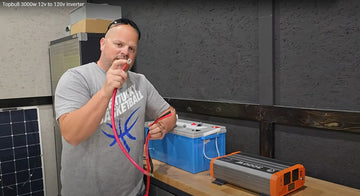During the leisurely days of golf, the golf cart is not only an important means of transport on the course, but also an important partner in enhancing the experience. Whether you're travelling between the greens or just hanging out in the community, the golf cart battery plays a key role, directly affecting its performance and range. However, with so many different types of batteries on the market, finding the best golf cart battery for your needs is a question worth pondering. In this article, we will delve into the basic types of golf cart batteries, their advantages, selection factors and pricing to provide you with practical advice that will help you make an informed decision and make every golfing trip smoother and more hassle-free.
What is a Golf Cart Battery
A golf cart battery is a specially designed deep-cycle battery designed to provide a steady power output over an extended period of time. Unlike standard car batteries that are used to start the engine for short periods of time, golf cart batteries are capable of steady discharge for hours on end. As a type of accumulator, these batteries are used to store a limited amount of electrical energy and release it when needed. Currently, they are used in a variety of equipment such as golf carts, electric tour buses, electric observation vehicles, and electric sweepers.
Basic Types of Golf Cart Batteries
Basic Types of Golf Cart Batteries When choosing a golf cart battery, it is important to understand its basic types. The main types are as follows:
Lead Acid Batteries
Lead acid batteries are the most traditional and common type of golf cart batteries. These batteries are usually found in 6V, 8V, or 12V configurations and are connected in series to meet the voltage requirements of the golf cart.
Pros:
- Relatively low cost for those on a budget.
- Mature technology with more brands and models available on the market.
- Maintenance is relatively simple.
Disadvantages:
- Heavier, which affects the performance and range of the vehicle overall.
- Typically shorter lifespan (usually 3 to 5 years).
- Lower efficiency and longer charging times.
Gel Lead Acid Batteries
Colloidal lead acid batteries are a modified version of lead acid batteries that use a colloidal electrolyte to improve safety and durability.
Pros:
- More resistant to shock and vibration, suitable for golf cart driving conditions.
- Lower maintenance requirements, less frequent water refilling compared to traditional lead-acid batteries.
Disadvantages:
- Relatively high cost, prices will be higher than regular lead-acid batteries.
Lithium Battery
Lithium batteries are a golf cart battery option that has grown in popularity in recent years, using lithium-ion technology, usually 12V batteries.
Pros:
- Smaller and lighter, which can significantly lighten the load on your golf cart.
- High energy density, providing longer range.
- Longer life, typically up to 8 to 10 years.
- Fast charging, with much shorter charging times.
Disadvantages:
- Higher initial investment, usually more expensive than lead-acid batteries.
Lead acid or lithium batteries for golf cart batteries?
Whether to choose lead acid or lithium batteries for golf cart batteries depends largely on individual needs, budget, and requirements for battery performance.
Lead-acid batteries, as traditional golf cart batteries, have the advantage of mature technology and lower cost. They have a wide range of applications in golf carts and are relatively easy to maintain. However, lead-acid batteries also have some shortcomings, such as higher weight and lower energy density, which may affect the handling and range of golf carts. In addition, lead-acid batteries have a relatively short cycle life and require periodic replacement.
In contrast, lithium batteries have the advantages of light weight, high energy density and long cycle life. These features make lithium batteries an emerging technology in the field of golf cart batteries, and they are gradually becoming more and more popular. Lithium batteries are able to provide golf carts with longer-lasting and more stable power, while reducing the overall weight of the vehicle and improving handling and range. However, lithium batteries typically cost more than lead-acid batteries and require specialised charging equipment and maintenance knowledge.
Therefore, when choosing a golf cart battery, you should weigh it against your actual needs and budget. If a lighter, higher energy density and longer life battery is desired and budget allows, then lithium batteries are the better choice. If cost-effectiveness is more of a priority, or if the battery performance requirements are not particularly high, then lead-acid batteries are also a good choice.
Key Factors in Choosing a Golf Cart Battery
When choosing a golf cart battery, there are several key factors that really need to be carefully considered to ensure that the battery you choose will meet your usage needs and perform well. Below is a further expansion on a few of the key factors you have mentioned:
Capacity (Ah)
The capacity of a battery is usually expressed in Ampere-hours (Ah), which reflects the product of the amount of current the battery can deliver under certain conditions and the time it takes to deliver it. For golf cart batteries, a higher capacity means that the more energy it can deliver, the better the range. Therefore, when choosing a battery, you need to select the right capacity for your usage needs. If your golf car needs to be driven for long periods of time or over long distances, then choosing a high capacity battery will be more appropriate.
Voltage
The electrical system of a golf car requires a specific voltage to drive it, so when choosing a battery you need to know what voltage your golf car requires (e.g. 36V or 48V) and make sure that the battery you choose is able to meet this requirement. If the battery voltage is not matched to the vehicle's electrical system, it may prevent the vehicle from operating properly or damage the electrical system.
Charge Time
Charging time is another important factor to consider when choosing a golf cart battery. If your golf cart is used more frequently, it will be more convenient to choose a battery that charges faster. Lithium-ion batteries usually have a faster charging speed and can be fully charged in a short period of time, thus meeting the demands of frequent use. Lead-acid batteries, on the other hand, are relatively slow to charge and may take longer to recharge.
Durability and longevity
Battery durability and longevity are also key factors to consider when choosing a golf cart battery. Lithium batteries typically have a longer lifespan and greater durability than lead-acid batteries. Lithium batteries have a longer cycle life and can withstand more charge and discharge cycles without significant loss of performance. Lead-acid batteries, on the other hand, have a relatively short lifespan and may experience problems such as sulphation during use, requiring regular maintenance and treatment.
Additionally, when choosing a golf cart battery, you will need to consider factors such as the weight, size, safety, and price of the battery. The weight and size need to ensure that the battery can be easily installed in the golf cart and will not negatively affect the handling of the vehicle. In terms of safety, you need to choose a battery that has safety features such as explosion-proof and leak-proof to ensure that there are no accidents during use. In terms of price, you need to choose the right battery according to your budget to avoid blindly pursuing high-end products and ignoring the cost-effectiveness.
To sum up, when choosing golf cart batteries, you need to comprehensively consider several key factors such as capacity, voltage, charging time, durability and service life, and make a wise choice according to your own usage needs and budget.
Price range of golf cart batteries
The price range of golf cart batteries can vary depending on the battery type, brand, capacity and other factors. Below are general price ranges:
Lead-acid batteries:
Typically priced between $100 and $300, they are more economical and suitable for those on a budget. High-capacity or deep-cycle lead-acid batteries may cost more.
Gel lead-acid batteries:
Typically priced between $200 and $400 because they offer better shock resistance and lower maintenance requirements.
Lithium batteries:
Lithium batteries are available in a wider price range, typically between $600 and $2,000, depending on battery capacity and brand. Although the initial investment is higher, they may be more cost-effective in the long term given their longer life and low maintenance costs.
Best Golf Cart Lithium Battery Recommendations

The 36V105AH LiFePO4 battery is a premium product that combines high performance and safety, using Grade A LiFePO4 battery cells to provide a capacity of 4.03kWh and a high power output of 7,680W, capable of a continuous discharge current of 200A to meet the needs of high-power equipment such as golf carts and trolling boats. It supports a range of up to 30-50 miles and has a 5-hour fast-charge capability, as well as a built-in 200A battery management system (BMS) and a high-strength, waterproof and shockproof enclosure to provide comprehensive safety for users.
With a cycle life of over 4,000 cycles and a significant weight reduction of 50% compared to lead-acid batteries, the battery is easy to carry and install, and with a 2.8-inch touch screen and mobile phone app monitoring function that allows users to easily manage the battery status at any time, this battery is the perfect combination of high efficiency, convenience, and intelligence, making it an ideal choice for your travelling needs.
FAQs
How can I tell when my battery needs to be replaced?
You can tell if your battery needs to be replaced by looking at the following signs:
- The range of the golf cart is significantly reduced.
- Significant increase in charging time and the battery is not fully recharged.
- Lack of power and reduced vehicle performance during use.
- Abnormalities such as leakage, swelling or corrosion on the outside of the battery.
Can you use a 36 volt battery in a 12 volt golf cart?
No. 12-volt golf carts are designed for use with 12-volt batteries. Using a 36-volt battery can cause damage to the electrical system and may result in a safety hazard. The voltage of each battery must be matched to the electrical system of the golf cart.
How far can a 48-volt golf cart go on a full charge?
The range of a 48-volt golf cart on a full charge is typically between 25 and 50 miles (approximately 40 to 80 kilometres), depending on factors such as battery capacity, vehicle weight, terrain and driving habits.
What is the optimum voltage for a golf cart battery?
The optimum voltage for a golf cart depends on the vehicle's design and electrical system. Typically, 12, 36 and 48 volts are common voltage configurations for golf carts. Of these, 48-volt battery systems are more popular because they offer more power and efficiency.
How many 12-volt batteries are in a golf cart?
The number of 12-volt batteries used in a golf cart depends on the system voltage. For example, a common 48-volt golf cart is usually configured with four 12-volt batteries, while a 36-volt golf cart typically uses three 12-volt batteries.
Can golf cart batteries be used in extreme weather?
Lithium-ion batteries perform better in extreme weather conditions, while lead-acid batteries may degrade in extreme cold temperatures. As a general rule, you should try to avoid exposing your battery to extreme high or low temperatures to prolong the life of your battery.
What is the charging time for golf cart batteries?
Lead-acid batteries typically take between 6 and 8 hours to recharge, while lithium batteries take a relatively short time to recharge and are usually full within 2 to 4 hours. The exact time also depends on the type of charger and the capacity of the battery.
How do I maintain my golf cart battery?
Maintaining lead-acid batteries involves checking electrolyte levels and adding water regularly, keeping terminals clean and avoiding corrosion. Lithium batteries require less maintenance, but ensure you use a compatible charger and avoid over-discharging the battery to prolong battery life. Ensure that they are charged regularly and stored within a suitable temperature range.

















